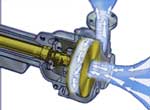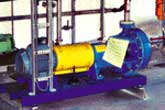Discflo Ansi Pump Smooths Over Tough Pumping Problems For Expensive Chemical Products


In many chemical pumping applications, it all comes down to this - the smoother the flow, the better the product quality and yield.
A chemical processor in the UK was experiencing terrible losses in a centrifuge feed of delicate and expensive crystal slurry. The progressing cavity pump was leaky, unreliable, and causing unacceptable product damage. Looking beyond the choices in conventional pumps, the company decided to install an ANSI standard disc-operated pump.
Disc pumps are unique; they operate on boundary layer/viscous drag forces that produce a laminar flow with no pulsation. A boundary layer of fluid adheres to the discs as fluid enters the pump. As the discs rotate, kinetic energy is transferred through layers of fluid molecules between the discs, generating velocity and pressure gradients until the entire fluid mass is in motion. The fluid is pulled through the pump in a smooth, laminar flow.
The ANSI Disc pump installed in the centrifuge feed application operates the same way. The ANSI Disc pump a significant advance in ANSI standard pumping. It meets or exceeds ANSI B73.1 standards, but pumps severe abrasives and levels of viscosity and entrained air that are many times higher than other ANSI pumps available today.
Nothing can surpass the performance of the Disc pump in this crystal slurry centrifuge feed. First, non-impingement pumping and laminar flow conditions provide the best protection for shear-sensitive and delicate products. There is almost zero impact on the product.
Second, laminar flow means low NPSHr (net positive suction head required). The NPSH requirements of a disc pump are about half to a third of what is required with conventional pumps.
Third, centrifuge feed applications are typically low flow and low NPSHa (net positive suction head available). Cavitation is a big problem under these conditions. The Disc pump is far less susceptible to cavitation because its laminar flow and low NSPH requirements. When cavitation does occur in the Disc pump, its boundary layer of fluid acts as a shock absorber, minimizing damage and vibration. Even under low NPSH conditions, Disc pumps suffer little damage or wear. In many cases, Disc pumps have continued to operate for years in a state of cavitation without loss of performance.
One last thing - no impingement means no wear. This is critical because it means no metal or rubber lining parts end up contaminating the product - a common problem with other pumps.
End users with shear-sensitive products have been able to improve their product yield and enhance plant reliability with disc technology. In the crystal slurry centrifuge feed, the net result was improved quality, total elimination of leaks, and dramatically increased reliability. The product and production details are proprietary, but they reported that production increased and processing time was reduced. Savings were significant enough that the Disc pump paid for itself in about one week's time.
Discflo Corporation, 1817 John Towers Avenue, El Cajon, CA 92020. Tel: 619-596-3181; Fax: 619-596-3973.
